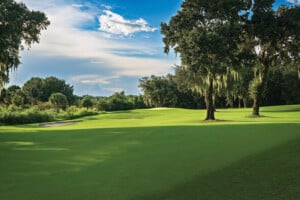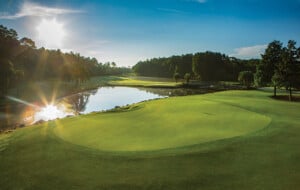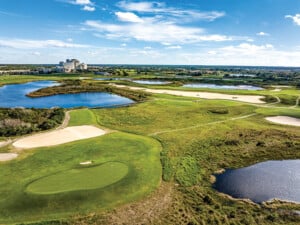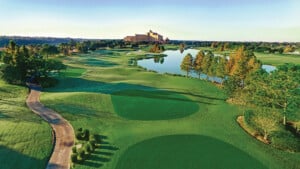The Most Challenging Holes In Central Florida
High stakes and low scores. These are the most challenging golf holes in Central Florida.
Maintaining a balance of ecological harmony, playability and timeless challenge is the proven blueprint that has made the heart of the Sunshine State home to everlasting golf experiences, says golf course architect Ricky Nix. These are some of the most challenging holes.
“It is our first priority to protect Florida’s environment and natural resources,” says Ricky Nix of Garl Nix Golf Course Design. “If possible, as designers, we look for opportunities to incorporate a natural feature into the strategy of the course design.”
Mystic Dunes Golf Club, Hole 6. Designed by Gary Koch, 1999.
A deceptively short par 5 at 495 yards tempts the unprepared to carry the ball. High sea levels, long gone, furrowed uncharacteristic ridges throughout Central Florida. Koch used these uncut gems to construct dramatic green elevations throughout the course, perhaps to the greatest effect on Hole 6. Waste area, wetlands and water run to the left of the rolling fairway, eventually clutching the green. A dog leg left is the least of the visibility challenges to the pin. Trees guard the approach on the right, compressing the fairway, showing mercy to those who opted to lay up left. A grand, 6-foot slope from the center of the green makes for an exaggerated finale.
Waldorf Astoria Golf Club, Hole 12. Designed by Rees Jones, co-designer Steve Weisser, 2009. Redevelopment by Rees Jones Inc., 2022.
Named after the founder of Hilton Hotels and Resorts, “Conrad” is a behemoth 623-yard par 5. The first landing area neighbors a bunker guarding the left of the fairway. Two vast, offset bunkers constrict the second landing area, saddling players with a choice—playing it safe and short of the sand will demand a lengthy third shot, but the bold are rewarded with a short approach. A deep swale to the right enhances the green elevation. Water traces the edge backing the green and flows down the left of the approach, where a greenside bunker lurks. Managing par feels as satisfying as sinking a birdie!
Hole 16 is the final par 3 reaching 172 yards from the back tees. “Doctor Jones” bears tribute to its designer, Rees Jones, who continues a legacy of astounding golf course architecture in the footsteps of his father, Robert Trent Jones, Sr. Having applied his prowess for restoration to several major championships, he has earned the honorific title, “The Open Doctor.” Water hems along the left of a slender fairway, flowing around the putting surface. Pin position influences a strategic recalibration of approach. Four bunkers surround the green, which is raised on the left and right. A swale passes between.
Walt Disney World Golf, “The Happiest Place On Turf!” Originally designed by Joe Lee, 1971.
Disney’s Lake Buena Vista Golf Course, Hole 1. While immersed in the magic of Disney Springs in the distance, keep in mind that position wins over power here. Sparkling water takes shape in a serpentine curve along the entire left side of this 509-yard opening par 5. Risking out of bounds to the right is no better an option than missing it left off the tee. Past the outstretch of meandering fairway it constricts, meeting a forward-facing sloping green. A pair of green side bunkers mark a highpoint in the green before sloping off to the back. The yardage, 6,718 in total, offers an exciting opportunity to use every club in your bag.
Redesigned by Arnold Palmer Design Co., 2013.
Disney’s Palm Golf Course, Hole 6. About 200 yards from the back tee the fairway widens. At first glance, a 409-yard par 4 doesn’t particularly intimidate. A large body of water curving along the left paired with a dramatic right-to-left slope defines the fairway contours. Sounds of nature enchant the senses, allowing for the necessary focus to plan your shot. Traveling down the fairway, the enchantment fades as challenge awaits. Palms lining the right-hand undulations cast a mirage over the wetland that borders the sprawling canal ahead. Approaching from here demands a lofty carry to an elevated, sloped green. Have no fear, the Mickey drop-zone is just across the bridge. The trend of optical illusions continues onto the green. A clear step-up in the middle slopes to a step-down on the right, behind the front bunker to a sucker pin position.
Mission Resort + Club, El Campeón, Hole 17. Designed by George O’Neil, 1917. Renovated by Charles E. Clarke, 1926.
A well-executed tee shot must thread between drawn-out sand traps on the left and hanging oaks to the right—the least of many hazards that earned this 556-yard par 5 the title, Devil’s Delight. Turf takes shape in an abrupt dog leg left, concealing upcoming complications for the second shot. Beware the historic live oak that looms surreptitiously ahead, positioned about 125 yards from the middle of the green. Playing to the right of this strategic sentinel could save par. A sizable bunker perches on the bank of a pond that separates the approach from the pin. The green descends forward toward the bordering hazard, threatening a deep approach with a devilish, downhill putt. Devil’s Delight has played the part of formidable foe for over a century, withstanding industry advancements and evolving playing style. Featured on the Florida Historic Golf Trail, El Campeón is a cornerstone of central Florida’s rich heritage of golf, and its trials continue to prod at nerves.
ChampionsGate Golf Club, International, Hole 6. Designed by Greg Norman, 2000.
The International is a signature design of testament demand. Norman recognized that the distinctive, untouched, topography was akin to coastal links across the Australian landscape. The magnificent test of position that lays await today weaves authentic links through Florida’s natural vista. The #1 handicap is a par 4 stretching 498 yards. Precision is tested by sweeping wind without the disruption of trees. From the tee, a large bunker guards the left of the narrow fairway. Fescue grass and marsh edge water weave an irregular path down the left of the hole’s length, squeezing the fairway betwixt a pond to the right. It takes a force carry with a wood or long iron over water to reach the fast, sloping green. The approach knots and rolls, beset with several pit bunkers. Although measures are made for playability, this hole requires tenacity from players of every skill level.
Shingle Creek Golf Club, Hole 17. Original Design By David Harman, 2003. Redesigned by Arnold Palmer Design Co., 2016.
Twisting the typical narrative of wide, flat Floridian courses, these severe green landscapes call for grit and sharp instinct. Golden-age style of play is not the only inspiration echoed in the undulations. The penultimate hole, Tobias’ Fire, bears namesake of a lead character’s willpower in A Land Remembered by Patrick D. Smith, a favorite of the late Harris Rosen, founder of Rosen Shingle Creek. One of many interconnected waterways runs the entire right side of this 220-yard par 3. Traps are perched left and short-right of the green at the end of a rolling fairway. Following suit, the putting surface slants toward the approach, showcasing billowed contours visible from the tee. Brave, yet calculated shots are advised to blaze your trail through this magnificent challenge.
Orange County National golf center and lodge, Crooked Cat, Hole 12. Designed by Phil Ritson, Dave Harman and Isao Aoki, 1998.
Elevated tees overlook a lush wetland guarding the forgiving first half of the fairway, wrapping down the right edge before meandering around the green. The second shot must be carried over outstretches of marsh, jutting from the water’s edge. Throughout, the fairway heaves and tapers toward a slender, two-tiered green. Wind flows unhindered over the 464-yard par 4, adding an elemental complication to Hole 12, dubbed The Sweep. A bunker to the left of the green sits beside a steep bail-out area nestled between the uppermost tier and a fairway mound. The deeper tier slants toward the water hazard. The course was formerly British Open training grounds for touring pros like Tiger Woods, Mark O’Meara and John Cook. Tactical challenges spanning 7,388 yards are well-suited for elite players.
Arnold Palmer’s Bay Hill Club & Lodge, Hole 18. Original design By Dick Wilson, 1961. Redesigned by Arnold Palmer Design Co., 2009.
The closing hole at Bay Hill Club & Lodge has been the stage for iconic PGA Tour victories, encapsulating Palmer’s philosophy, “play boldly to win.” A drive too far right on this 495-yard par 4 will leave a daunting second shot over water. Even so, getting too comfortable with a right-to-left ball flight risks out of bounds along the left side. About 250 yards from the back tee, an expansive water hazard rears up the right-hand side. The fairway tightens, approaching three greenside bunkers that flank the left and back, leaving little to no bail-out in between. The green is curved and tightly guarded by a rocky embankment, eager to punish a timid shot. Forty paces of depth allow for plenty of different pin placements. In the last 25 years, only five players have won the Arnold Palmer Invitational by more than three strokes.
Streamsong Golf Resort, Red Course, Hole 16. Designed by Bill Coore and Ben Crenshaw, 2012.
Players face a visually arresting landscape of magnificent sand dunes, expansive lakes and dramatic terrain that was once a phosphate mining site. This par 3 requires a shot over water, 208 yards from the back tee. “Depending on wind and hole location, [your tee shot] can range anywhere from a 9 iron to a driver,” remarks caddy Greg Corbo. The green extends 70 yards front to back, characterized by a 6-foot swale in the middle. A towering dune to the right is blanketed in native flora that swaths the periphery of the layout, excluding the steep collection area to the left. “The swale collection leaves an uphill chip to a contour you cannot see,” says Corbo. Streamsong is home to other-worldly scenery, while respecting local history, environment and the future of this historic sport.










